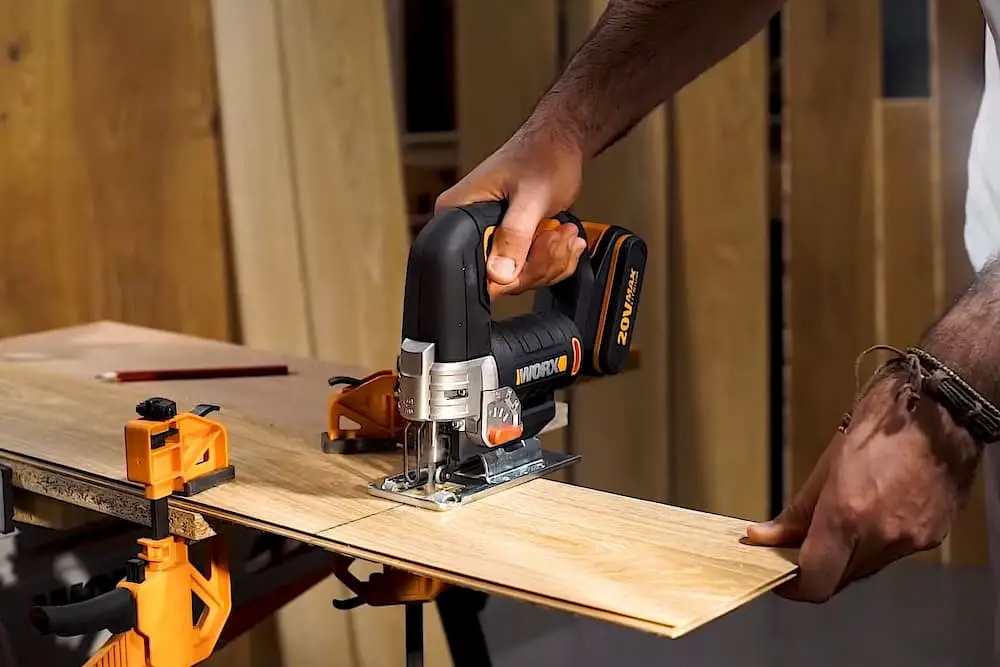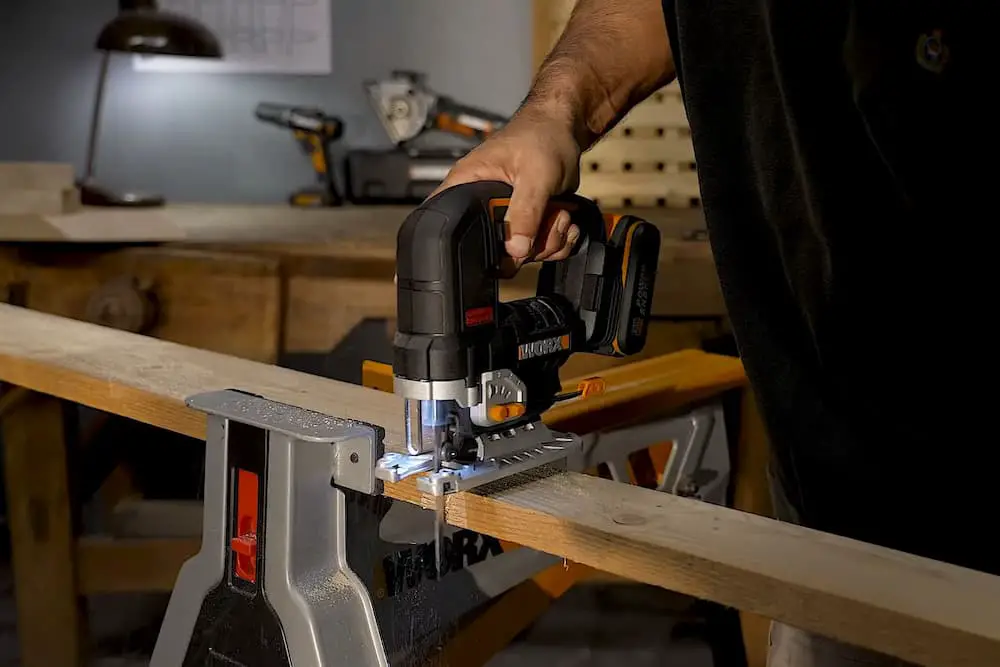Particle board is a popular choice for many DIY projects due to its affordability and versatility. However, cutting particle board can be a challenge, especially if you don’t have the right tools or techniques.
If you’ve ever tried to cut particle board with a jigsaw, you may have experienced chipping, splintering, or other frustrating issues. But don’t give up just yet!
With a few simple tips and tricks, you can achieve clean, precise cuts in particle board using a jigsaw. In this article, I’ll explore the best practices for cutting particle board with a jigsaw, including choosing the right blade, clamping the board, using proper technique, and finishing the edges. You’ll learn everything you need to know to make your next particle board project a success.
So grab your jigsaw and let’s get started!
What is a particle board?
Particle board, also known as chipboard, is a type of engineered wood product made from small wood particles, sawdust, or wood chips, mixed with resin or another binder and then compressed and shaped into boards or panels. The resulting material is dense, strong, and affordable, making it a popular choice for a wide range of applications, including furniture, cabinetry, flooring, and construction.
Other common names for particle board include low-density fiberboard (LDF), medium-density fiberboard (MDF), oriented strand board (OSB), and waferboard.
Can you cut particle board with a jigsaw?
Yes, you can cut particle board with a jigsaw. In fact, a jigsaw is a popular tool for cutting particle board due to its versatility, portability, and ability to make curved and intricate cuts.
It’s important to use the correct blade for cutting particle board, such as a fine-toothed blade, to prevent chipping or splintering of the material.
You should use eye and ear protection and secure the particle board firmly before cutting to prevent it from moving around or vibrating excessively during the cutting process.
How to cut particle board with a jigsaw?
Cutting particle board with a jigsaw is a relatively straightforward process. Here are the steps to follow:
- Choose the right blade: As mentioned earlier, it’s important to select the correct type of jigsaw blade for cutting particle board. A fine-toothed blade with a high number of teeth per inch (TPI) is ideal for this job, as it will produce cleaner cuts with minimal chipping or splintering.
- Measure and mark the board: Use a measuring tape and a pencil to mark the area where you want to cut the particle board. Make sure your measurements are accurate, and double-check them before proceeding.
- Clamp the board securely: Use clamps or a vise to hold the particle board firmly in place. This will prevent it from vibrating or moving around during the cutting process, which could result in inaccurate cuts or even damage to the blade or the board.
- Adjust the speed and angle of the jigsaw: Set the speed of your jigsaw to a medium or high setting, depending on the thickness of the particle board. You may also need to adjust the angle of the blade to achieve the desired cut, especially if you are cutting curves or intricate shapes.
- Begin cutting: Start the jigsaw and slowly guide the blade along the marked line. Take care to keep the blade perpendicular to the board and avoid applying too much pressure, which can cause the blade to bend or break.
- Finish the cut: Once you have completed the cut, turn off the jigsaw and carefully remove the clamps. Use a sanding block or sandpaper to smooth any rough edges or surfaces.
Following these steps will help you cut particle board with a jigsaw safely and effectively but you might need to practice to get consistent results.

How to prevent particle board chipping and splintering?
You can preventing chipping and splintering particle board through a combination of proper technique and the right equipment. Here are some tips to prevent chipping and splintering:
- Use the right blade: Choose a jigsaw blade with fine teeth, such as a high TPI blade, as this will produce cleaner cuts with less chance of splintering. The blade should also be sharp and in good condition.
- Secure the board: Make sure the particle board is firmly clamped down or otherwise secured before cutting. This will prevent it from vibrating or moving during the cutting process, which can cause splintering or chipping.
- Mark the cut: Use a straight edge or other guide to mark the cut line on the particle board. This will help you cut in a straight line and reduce the chance of the blade wandering and causing splintering.
- Cut at a moderate speed: Avoid cutting too quickly or too slowly. A moderate cutting speed will help prevent the blade from overheating and causing splintering.
- Back up the cut: Place a piece of sacrificial wood or other backing material behind the particle board when making the cut. This will help prevent splintering on the back side of the board.
- Smooth out the cut: Once the cut is complete, use a sanding block or sandpaper to smooth out any rough or splintered edges.
What jigsaw blade do I need for cutting particle board?
The best jigsaw blade for particle board is a fine-toothed blade with a high number of teeth per inch (TPI). A blade with 10-12 TPI or higher is ideal for this type of cutting. These blades are specifically designed to make smooth, clean cuts in particle board without chipping or splintering.
When shopping for a jigsaw blade for particle board, look for one that is made of high-quality materials, such as high-speed steel (HSS) or carbide, and is suitable for cutting through the thickness of the particle board you are working with. Remember to choose the right blade for the job, as using the wrong blade can result in poor-quality cuts or even damage to the blade or the board.
What are alternative tools for cutting particle board?
There are several alternative tools that can be used for cutting particle board, depending on the specific needs of the project. Here are a few options:
- Circular saw: A circular saw is a versatile tool that can make long, straight cuts in particle board. It’s ideal for cutting larger sheets or panels of particle board, as it allows for more precision and control.
- Table saw: A table saw like Bosch 4100-10 is a stationary saw that is mounted on a table or workbench. It’s great for making precise, straight cuts in particle board, and can be used to cut large sheets or panels.
- Handsaw: A handsaw can be used for smaller cuts in particle board, such as cutting out shapes or making smaller, straight cuts. A back saw or panel saw can be especially effective for this purpose.
- Router: A router can be used to create intricate shapes and designs in particle board. It’s great for creating beveled or curved edges, or for cutting out decorative patterns.
When choosing a tool for cutting particle board, it’s important to consider the specific needs of your project, as well as your level of experience and comfort with each tool.

Conclusion
Cutting particle board with a jigsaw is a common DIY task, but it can be tricky to get clean, precise cuts without chipping or splintering.
In my experience, choosing the right blade and using proper technique can help achieve better results. A fine-toothed blade with high TPI is best for cutting particle board, and the board should be securely clamped down before cutting. Marking the cut and cutting at a moderate speed can help prevent blade wandering and overheating. Backing up the cut with a sacrificial piece of wood or other material can help prevent splintering on the back side of the board. Once the cut is complete, sanding the edges can smooth out any rough spots or splinters.
You may consider using other tools that are available to you, such as circular saws, table saws, handsaws, and routers to cut particle board, depending on the specific needs of your project.
